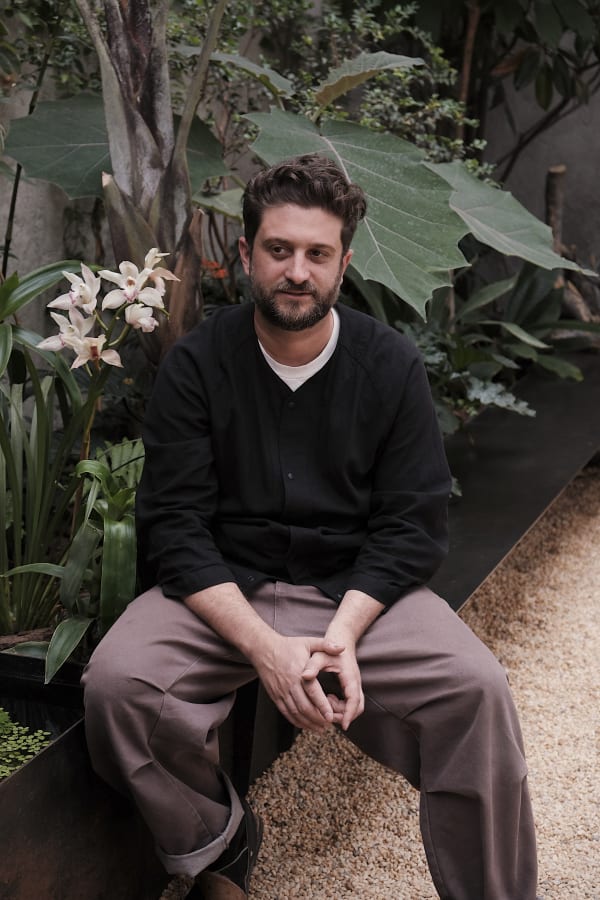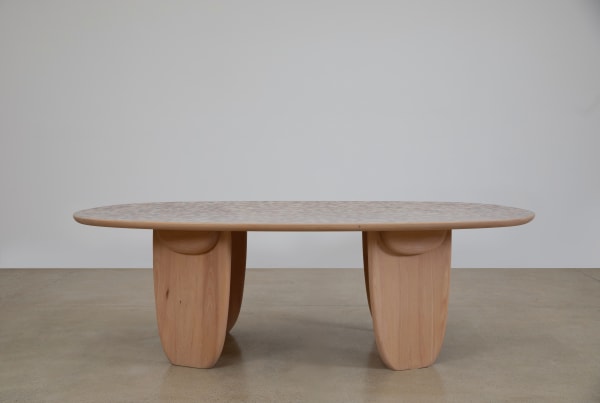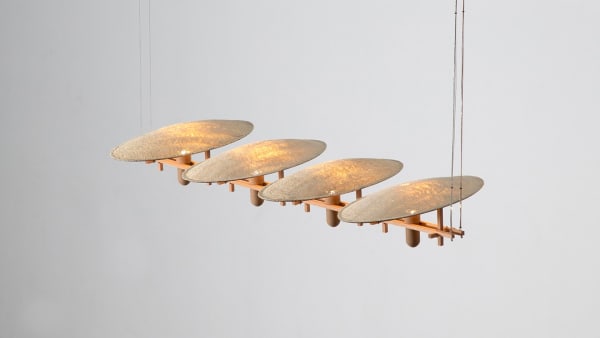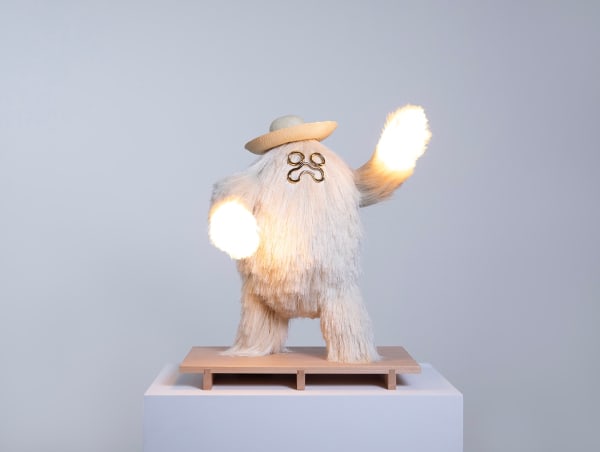Fernando Laposse
The first Gold is Green
페르난도 라포세는 멕시코 지역의 역사와 전통, 환경적 맥락을 반영한 토착 디자인(endemic design)을 실천하며 현대사회의 환경위기에 대한 지속 가능한 실질적 대안을 제시한다. 작가는 작물 생산 과정에서 버려지는 잎과 껍질과 같은 잉여물을 가구 제작에 적합한 재료로 가공하여 친환경적 재료의 가능성을 확장한다. 그는 옥수수, 아보카도 껍질, 아가베 섬유, 수세미(loofah) 등 멕시코의 토착작물에 지역문화와 정체성을 반영한 가구와 오브제를 제작한다.
천연 재료에 풍부한 서사를 담아내는 작가 페르난도 라포세는 혹독한 겨울을 견뎌낸 첫 새싹의 소중함과 연약함을 담은 로버트 프로스트의 시, <어떤 황금도 영원치 못하리라(Nothing Gold Can Stay)>의 첫 구절 “자연의 첫 초록은 황금과 같고”를 천연자원의 상품화에 비유로 재해석했다. 그는 멕시코 남서부의 원주민 공동체 토나후이스틀라(Tonahuixtla)와 세계 최대의 옥수수 생식세포 및 종자 은행(CIMMYT)와 협력하며, 소외된 지역 사회의 현실을 조명하고 전통 농업 방식의 보존에 힘쓴다. 나아가 환경 파괴, 생물 다양성 상실, 농촌 공동체 붕괴, 글로벌 무역의 부정적 영향 등 복합적인 문제들을 다루며, 디자인이 지역 사회 문제를 해결하는 본질적인 도구로 기능할 수 있음을 보여준다.
멕시코의 농촌지역은 글로벌 무역과 단기적 자본이익에 기반한 무리한 개발로 생태적 위기에 처해있다. 이번 전시는 페르난도 라포세가 지난 10년간 대안적인 재료실험과 공동체와의 협업을 진행한 연구성과를 집약한 자리로 옥수수 껍질로 개발한 신소재 토토목슬(Totomoxtle) 캐비닛과 테이블, 아보카도 씨와 껍질로 제작된 캐비닛, 천연 수세미로 만든 조명 시리즈, 아가베 잎에서 추출된 섬유로 만든 대형 몬스터 조명 등을 선보인다.
Fernando Laposse practices endemic design, a methodology rooted in the history, traditions, and ecological contexts of Mexico, offering sustainable and tangible alternatives to the environmental crises of contemporary society. By transforming agricultural byproducts such as husks and leaves into materials suitable for furniture-making, he expands the possibilities of environmentally conscious design. His works incorporate native Mexican crops—such as corn, avocado skins, agave fibers, and loofah—into furniture and objects that reflect local culture and identity.
Fernando Laposse, an artist who weaves rich narratives into natural materials, reinterprets the opening line of Robert Frost’s poem Nothing Gold Can Stay—“Nature’s first green is gold”—as a metaphor for the commodification of natural resources. Just as Frost reflects on the fragility and preciousness of the first sprouts after a harsh winter, Laposse draws attention to the vulnerability of nature within systems of consumption and trade. Collaborating with the Indigenous community of Tonahuixtla in southwestern Mexico and with CIMMYT, the world’s largest maize germplasm and seed bank, Laposse highlights the challenges faced by marginalized rural societies while advocating for the preservation of traditional farming practices. His projects address urgent issues such as environmental degradation, biodiversity loss, the collapse of rural communities, and the adverse impacts of global trade, demonstrating how design can function as a vital tool for social and ecological problem-solving.
Rural regions of Mexico are facing severe ecological crises driven by global trade and short-term economic interests. This exhibition presents the culmination of Laposse’s decade-long exploration of alternative materials and collaborative practices with local communities. On view are works such as Totomoxtle cabinets and tables crafted from corn husks, cabinets made from avocado seeds and skins, lighting series created with natural loofah, and monumental lamps woven from agave fibers—demonstrating design’s potential as both ecological innovation and cultural preservation.
-
 Fernando LaposseTotomoxtle Snake Dining Table, 2024Heirloom corn husk marquetry on beech, eco-resin240 × 74 × 115 cmEdition 1 of 3 plus 2 artist's proofs, Prototype
Fernando LaposseTotomoxtle Snake Dining Table, 2024Heirloom corn husk marquetry on beech, eco-resin240 × 74 × 115 cmEdition 1 of 3 plus 2 artist's proofs, Prototype -
 Fernando LaposseAvocado Bar, 2024Avocado skin marquetry, solid walnut, steel structure, brass interiors, hardware, glass
Fernando LaposseAvocado Bar, 2024Avocado skin marquetry, solid walnut, steel structure, brass interiors, hardware, glass
136 × 199 × 57 cmEdition of 8 plus 4 artist's proofs (P 1/1) -
 Fernando LaposseTotomoxtle Cabinet, 2024Corn husk marquetry, solid beech, brass hardware260 × 101.5 × 62 cmEdition of 8 plus 4 artist's proofs (P 1/1)
Fernando LaposseTotomoxtle Cabinet, 2024Corn husk marquetry, solid beech, brass hardware260 × 101.5 × 62 cmEdition of 8 plus 4 artist's proofs (P 1/1) -
 Fernando LaposseLoofah Floor Lamp, 2024Loofah, beechwood, 3D printed wood fiber, steel, stone31.5 × 140 × 46 cmEdition of 8 plus 4 artist's proofs (P 1/1)
Fernando LaposseLoofah Floor Lamp, 2024Loofah, beechwood, 3D printed wood fiber, steel, stone31.5 × 140 × 46 cmEdition of 8 plus 4 artist's proofs (P 1/1) -
 Fernando LaposseLoofah Ceiling Lamp, 2024Loofah, beechwood, 3D printed wood fiber, steel117 × 15.5 × 46 cmEdition of 8 plus 4 artist's proofs (P 1/1)
Fernando LaposseLoofah Ceiling Lamp, 2024Loofah, beechwood, 3D printed wood fiber, steel117 × 15.5 × 46 cmEdition of 8 plus 4 artist's proofs (P 1/1) -
 Fernando LaposseLoofah Wall-Mounted Lamp, 2024Loofah, beechwood, 3D printed wood fiber, steel
Fernando LaposseLoofah Wall-Mounted Lamp, 2024Loofah, beechwood, 3D printed wood fiber, steel
46 × 25 × 28 cm
Edition of 20 plus 5 artist's proofs (P 1/1) -
 Fernando LapossePatachin, 2024Agave fibers, 3D printing filament, woven palma, beechwood, brass46.5 × 56 × 29.5 cm(P 1/1)
Fernando LapossePatachin, 2024Agave fibers, 3D printing filament, woven palma, beechwood, brass46.5 × 56 × 29.5 cm(P 1/1) -
 Fernando LapossePatachon, 2024Agave fibers, brass, 3D printing filament, plywood, steel structure178 × 220 × 110 cm(P 1/1)
Fernando LapossePatachon, 2024Agave fibers, brass, 3D printing filament, plywood, steel structure178 × 220 × 110 cm(P 1/1)
-

페르난도 라포세, 멕시코 자연 재료로 만든 지속 가능한 아트 퍼니처
행복이 가득한 집 October 15, 2025< 행복이 가득한 집> 10월 호 P. 167-169 멕시코 자연 재료로 만든 지속 가능한 아트 퍼니처 페르난도 라포세 Fernando Laposse 멕시코 출신 아티스트 페르난도 라포세는...Read more -

페르난도 라포세, 환경과 경제 지속 가능성을 이끄는 토착 디자인
Styler September 9, 2025 Read more -

페르난도 라포세, 한국 첫 개인전
The Press 1 August 29, 2025 Read more -

더페이지갤러리, 멕시코 디자이너 페르난도 라포세의 한국 첫 개인전,《자연의 첫번째 금은 초록 (The first Gold is Green)》개최
Maeil August 29, 2025페르난도 라포세는 멕시코 지역의 역사와 전통, 환경적 맥락을 반영한 토착 디자인(endemic design)을 실천하며 현대사회의 환경위기에 대한 지속 가능한 실질적 대안을 제시한다. 작가는 작물 생산 과정에서...Read more -

"자연의 첫번째 금(金)은 초록" 멕시코 작가 라포세의 '친환경 아트'
newspim August 28, 2025라포세는 서울 성동구 서울숲의 더페이지 갤러리 웨스트관에서 '자연의 첫번째 금은 초록'이라는 타이틀로 개인전을 갖는다. 전시제목은 미국을 대표하는 시인 로버트 프로스트(1874~1963)가 1923년에 발표한 시에서 차용한 것이다....Read more -

멕시코 디자이너 페르난도 라포세의 한국 첫 개인전 개최 전통 재료와 현대 디자인의 결합
Woodplanet August 28, 2025오는 28일, 멕시코시티를 기반으로 활동하는 디자이너 페르난도 라포세의 첫 한국 개인전이 성수동 더페이지갤러리에서 열린다. 런던 센트럴 세인트 마틴에서 제품 디자인을 전공한 그는 런던, 뉴욕, 파리...Read more










